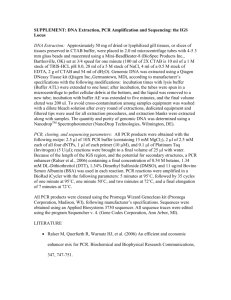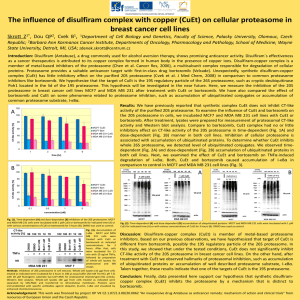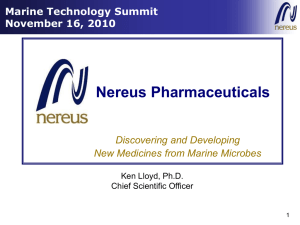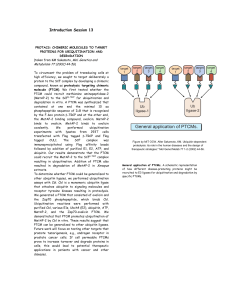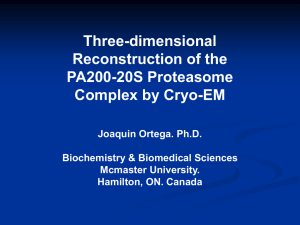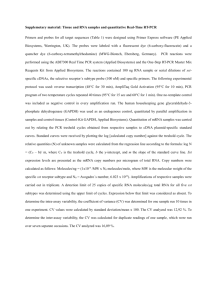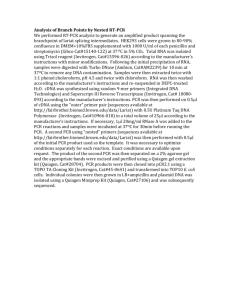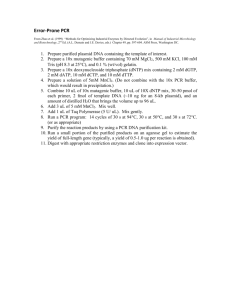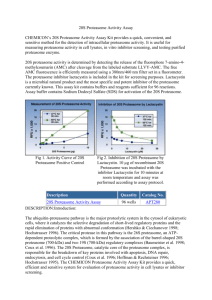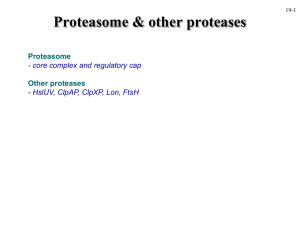Cell growth inhibition assay
advertisement
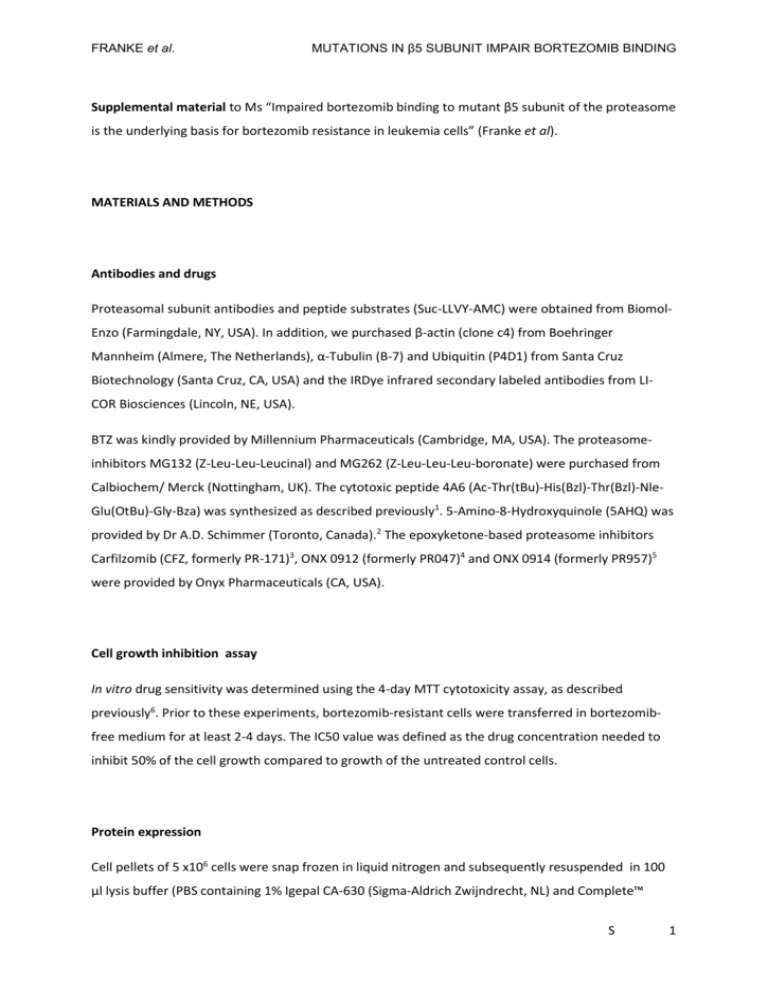
FRANKE et al. MUTATIONS IN β5 SUBUNIT IMPAIR BORTEZOMIB BINDING Supplemental material to Ms “Impaired bortezomib binding to mutant β5 subunit of the proteasome is the underlying basis for bortezomib resistance in leukemia cells” (Franke et al). MATERIALS AND METHODS Antibodies and drugs Proteasomal subunit antibodies and peptide substrates (Suc-LLVY-AMC) were obtained from BiomolEnzo (Farmingdale, NY, USA). In addition, we purchased β-actin (clone c4) from Boehringer Mannheim (Almere, The Netherlands), α-Tubulin (B-7) and Ubiquitin (P4D1) from Santa Cruz Biotechnology (Santa Cruz, CA, USA) and the IRDye infrared secondary labeled antibodies from LICOR Biosciences (Lincoln, NE, USA). BTZ was kindly provided by Millennium Pharmaceuticals (Cambridge, MA, USA). The proteasomeinhibitors MG132 (Z-Leu-Leu-Leucinal) and MG262 (Z-Leu-Leu-Leu-boronate) were purchased from Calbiochem/ Merck (Nottingham, UK). The cytotoxic peptide 4A6 (Ac-Thr(tBu)-His(Bzl)-Thr(Bzl)-NleGlu(OtBu)-Gly-Bza) was synthesized as described previously1. 5-Amino-8-Hydroxyquinole (5AHQ) was provided by Dr A.D. Schimmer (Toronto, Canada).2 The epoxyketone-based proteasome inhibitors Carfilzomib (CFZ, formerly PR-171)3, ONX 0912 (formerly PR047)4 and ONX 0914 (formerly PR957)5 were provided by Onyx Pharmaceuticals (CA, USA). Cell growth inhibition assay In vitro drug sensitivity was determined using the 4-day MTT cytotoxicity assay, as described previously6. Prior to these experiments, bortezomib-resistant cells were transferred in bortezomibfree medium for at least 2-4 days. The IC50 value was defined as the drug concentration needed to inhibit 50% of the cell growth compared to growth of the untreated control cells. Protein expression Cell pellets of 5 x106 cells were snap frozen in liquid nitrogen and subsequently resuspended in 100 µl lysis buffer (PBS containing 1% Igepal CA-630 (Sigma-Aldrich Zwijndrecht, NL) and Complete™ S 1 FRANKE et al. MUTATIONS IN β5 SUBUNIT IMPAIR BORTEZOMIB BINDING protease inhibitor cocktail (Boehringer Mannheim, Almere, NL) for 45 min at 4°C. Lysates were clarified by microcentrifugation at 14 000g during 5 min. Next, Laemli's sample buffer (Biorad, Veenendaal, NL) supplemented with 50 μl of β-mercaptoethanol/1 ml was added (lysis buffer: Laemli buffer =2:1). Lysates were heated at 95°C for 5 min, separated by dodecyl sulfate-polyacrylamide gel electrophoresis (SDS-PAGE) (7.5–12.5%) and electroblotted (30 V, 12 h) onto Immobilon-FL PVDF membranes (Millipore, Billerica, MA, USA). Next, membranes were washed with PBS, incubated for 1 h in Odyssey blocking buffer (Li-cor biosciences, Lincoln, NE, USA) and incubated with the primary antibody for 1h at RT. Thereafter, membranes were washed with PBS-Tween and incubated with infrared labeled secondary antibody for 1 hour at RT. After washing four times in PBS, proteins were visualized using the Odyssey® Infrared Imaging System (Li-cor biosciences, Nebraska, USA). Protein levels of the catalytic proteasomal subunits were also quantified using a sandwich ELISA method as described previously by Parlati et al.7 Native gel electrophoresis Characterization of the proteasome (detection of core/regulatory particles and suc-Leu-Leu-Val-TyrAMC hydrolysis activity), in WT and BTZ-resistant cells by native gel electrophoresis was performed essentially as described by Elsasser et al.8 using acid washed glass beads (Sigma) for the preparation of lysates. Subsequent western blot analysis was performed as described above. Quantative RT-PCR and cDNA synthesis of proteasome subunits After RNA isolation by the TRIzol method (Invitrogen), cDNA was synthesized using RT buffer (Invitrogen), containing 5mM DTT (Invitrogen), 2mM dNTP(Roche), pdN6 96ug/ml (Roche), 0.75U/ul M-MLV (Invitrogen) and 2U/ul RNAsin (HT Biotechnology Ltd., Cambridge, UK). mRNA expression levels of proteasome subunits PSMB5 (β5), PSMB6 (β1), PSMB7 (β2) and the endogenous housekeeping gene β-glucuronidase (GUS) as a reference were quantified using real-time PCR analysis (Taqman) on an ABI Prism 7700 sequence detection system (PE Applied Biosystems, Nieuwerkerk a/d IJssel, The Netherlands). Primers-probe combinations and concentrations used for the quantitative real-time PCR. All probes were labeled with 5’-FAM and 3’-BHQ1 as a reporter. Primers and probes were designed using Primer Express software (Applied Biosystems) as follows: PSMB5 forward (50 nM): CTTCAAGTTCCGCCATGGA; PSMB5 reverse (300 nM): CCGTCTGGGAGGCAA S 2 FRANKE et al. MUTATIONS IN β5 SUBUNIT IMPAIR BORTEZOMIB BINDING TGTAA; PSMB5 probe (200 nM): TTGCAGCTGACTC CAGGGCTACAGC; PSMB6 forward (300 nM): AGGCATGACCAAGGAAGAGTGT; PSMB6 reverse (50 nM): GAGCCATCCCGCTCCAT; PSMB6 probe (200 nM): TGCAATTCACTGCCAAT GCTCTCGC; PSMB7 forward (300 nM): TCGGTGTA TGCTCCACCAGTT; PSMB7 reverse (50 nM): GCAAAATCGGCTTCCAAGAC; PSMB7 probe (200 nM): TTCTCTT TTGATAACTGCCGCAGGAATGC; GUS forward (300 nM): GAAAATATGTGGTTG GAGAGCTCATT; GUS reverse (300 nM): CCGA GTGAAGATCCCCTTTTTA; GUS probe (200 nM): CCAGCACTCTCGTCGGTGAC TGTTCA. Real-time PCR was performed in a total reaction volume of 50 μl containing TaqMan buffer A (Applied Biosystems), 4 mM MgCl2, 0.25 μM of each dNTP (Amersham Pharmacia Biotech) and 1.25 U AmpliTaq Gold DNA polymerase (Applied Biosystems). Samples were heated for 10 min at 95°C to activate the AmpliTaq Gold DNA polymerase and amplified during 40 cycles of 15 s at 95°C and 60 s at 60°C. Relative mRNA expression levels of the target genes in each sample were calculated using the comparative cycle time (Ct) method.9 The Ct of the target gene is normalized to the GUS PCR Ct value by subtracting the GUS Ct value from the target Ct value. The mRNA expression level for each target PCR relative to GUS was calculated using the following equation: mRNA expression = 2(Ct target-Ct GUS) × 100%. Sequence analysis DNA was isolated from wild-type (WT) and BTZ resistant cells using a Qia amp DNA blood mini kit (250) (Qiagen, Valencia, CA, USA). Subsequently, the region of interest of the PSMB5, PSMB6 or PSMB7 gene was amplified by PCR. The primers were designed using Vector NTI (Invitrogen) software and depicted in supplementary table S1. PCR products were directly sequenced by dideoxy chaintermination method using a kit ABI PrismTM BigDye Terminator (Perkin Elmer, Foster City, CA, USA) and analyzed by an autosequencer ABI Prism Genetic Analyser 3100 automatic DNA sequencer (Perkin Elmer). S 3 FRANKE et al. MUTATIONS IN β5 SUBUNIT IMPAIR BORTEZOMIB BINDING References 1 de Jong MC, Slootstra JW, Scheffer GL, Schroeijers AB, Puijk WC, Dinkelberg R, et al. Peptide transport by the multidrug resistance protein MRP1. Cancer Res 2001; 61: 2552-7. 2 Li X, Wood TE, Sprangers R, Jansen G, Franke NE, Mao X, et al. Effect of noncompetitive proteasome inhibition on bortezomib resistance. J Natl Cancer Inst 2010; 102: 1069-82. 3 Demo SD, Kirk CJ, Aujay MA, Buchholz TJ, Dajee M, Ho MN, et al. Antitumor activity of PR-171, a novel irreversible inhibitor of the proteasome. Cancer Res 2007; 67: 6383-91. 4 Chauhan D, Singh AV, Aujay M, Kirk CJ, Bandi M, Ciccarelli B, et al. A novel orally active proteasome inhibitor ONX 0912 triggers in vitro and in vivo cytotoxicity in multiple myeloma. Blood 2010; 116: 4906-15. 5 Muchamuel T, Basler M, Aujay MA, Suzuki E, Kalim KW, Lauer C, et al. A selective inhibitor of the immunoproteasome subunit LMP7 blocks cytokine production and attenuates progression of experimental arthritis. Nat Med 2009; 15: 781-7. 6 Kaspers GJ, Pieters R, Van Zantwijk CH, De Laat PA, De Waal FC, Van Wering ER, et al. In vitro drug sensitivity of normal peripheral blood lymphocytes and childhood leukaemic cells from bone marrow and peripheral blood. Br J Cancer 1991; 64: 469-74. 7 Parlati F, Lee SJ, Aujay M, Suzuki E, Levitsky K, Lorens JB, et al. Carfilzomib can induce tumor cell death through selective inhibition of the chymotrypsin-like activity of the proteasome. Blood 2009; 114: 3439-47. 8 Elsasser S, Schmidt M, Finley D. Characterization of the proteasome using native gel electrophoresis. Methods Enzymol 2005; 398: 353-63. 9 Meijerink J, Mandigers C, van de LL, Tonnissen E, Goodsaid F, Raemaekers J. A novel method to compensate for different amplification efficiencies between patient DNA samples in quantitative real-time PCR. J Mol Diagn 2001; 3: 55-61. S 4

